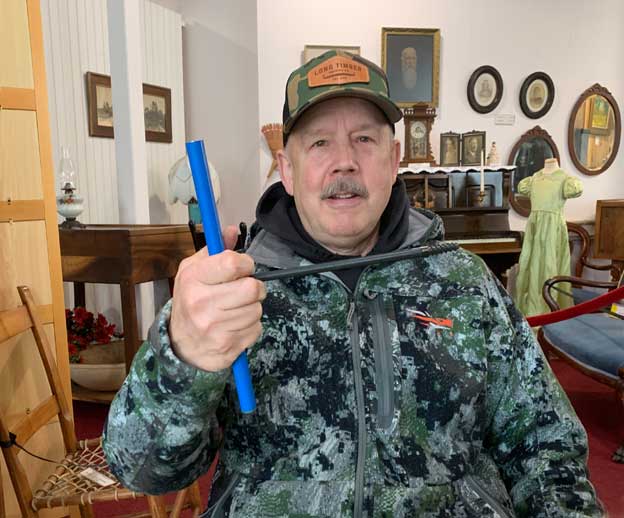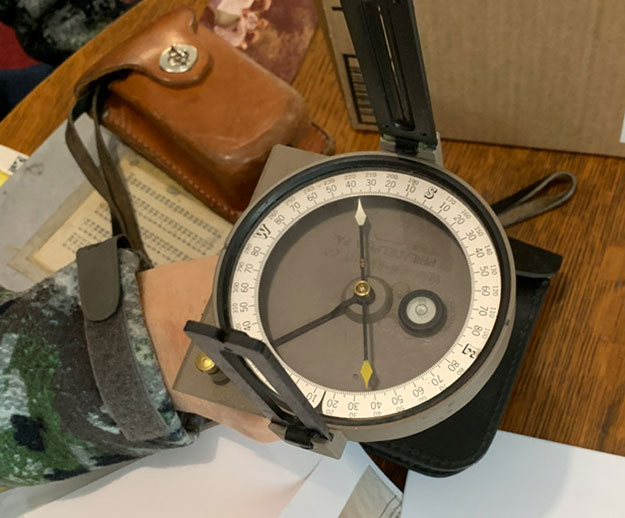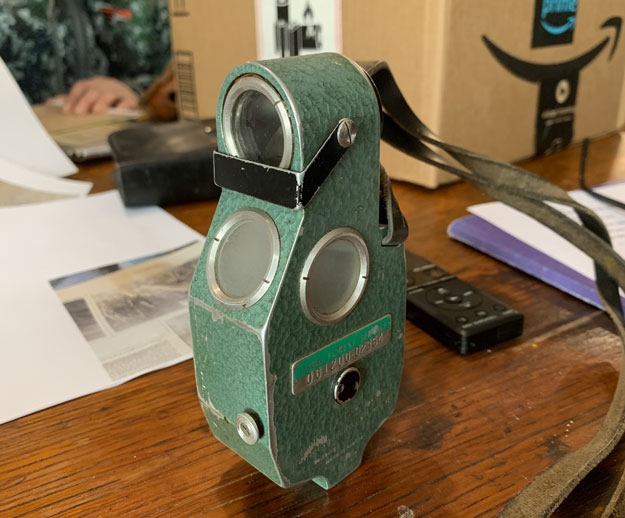
MARC WANGERIN
It’s often said it takes a certain kind of person to do the type of work a job requires. That can be said of Marc Wangerin. Born in 1956, he grew up in Elmira on a mink farm where his father was a furrier. Marc pursued a career in Forestry at Lane Community College shortly after high school. He found his ‘calling’ with the United States Forest Service (USFS), Mapleton Ranger District. He remained there until 1993, after nearly 20 years of service.
He still speaks with a humble reverence when recalling how proud he was to wear his uniform and name badge. Marc used many forestry and logging terms during our interview, pausing to provide details while explaining what each meant. His first work assignment was on a brush disposal crew. It was a job responsible for burning logging slash – the debris remaining after an area is logged. He described it as physically demanding fire-work, involving exposure to intense heat for uncomfortable lengths of time. In addition to other primary responsibilities, it was a task performed by everyone throughout their Forest Service careers.
For many years, Marc’s primary job was timber cruising — measuring forest stands (45 to 50 acres) to determine tree characteristics such as average size, volume, and quality. He indicated these measurements are essential to estimate the volume and value of timber.
A MINDFUL METHOD
Marc worked during controversial years. It was at a time when some viewed old growth trees as having more historical and environmental significance standing rather than logged. He explained federal requirements mandate companies replant 5 trees for every tree harvested. Replanted trees resulted in approximately 400 trees per acre. This allows for high quality trees to proliferate while still allowing harvesting of other trees. Rather than simply creating volume, this method is intended to have multiple benefits. It was designed to reproduce trees with old growth characteristics, while also helping the spotted owl. Instead of focusing on the diameter of a tree, the method is designed to create a “layering effect.” In a natural old growth stand, the layers are comprised of Douglas Fir trees which are primarily the tall trees. Under those, grow naturally seeded shade tolerant trees (western hemlock and western red cedar). They act as understory trees, supplying an ideal location for spotted owls to nest in. Additionally, they also provide a desired environment for the owls to land and view foraging areas below. In the end, Marc stated commercial thinning is the only harvesting the Siuslaw National Forest engages in.
I can say with confidence that not one mature tree has been harvested since about 1990 in the Siuslaw National Forest. It’s all coming from the 2nd and 3rd growth trees. M. Wangerin
MANAGING THE FOREST
As the smaller trees grow, in about their 15th year the surrounding space becomes crowded. Trees in a crowded environment stop adding girth. In other words as they grow towards the sunlight, they cease putting on wood. To create wider space to maintain a healthy forest, the trees are pre-commercially thinned out. Those pre-commercially thinned trees are cut down and simply left to decompose. The remaining trees are allowed to grow until about age 30 to 40 years. To reduce the volume, those trees are then commercially thinned out for sale to timber companies and lumber mills through timber sales conducted by USFS. Subcontractors are hired by those companies to harvest the timber.
WORK OF A TIMBER SALE PLANNER
Prior to leaving the service in 1993, Marc was a timber sale planner. He worked with skilled specialists to produce an environmentally sound project. They included hydrologists, soil scientists, fish and wildlife biologists, archeologists, silviculturalists, fire technicians and engineers. His role was that of a logging systems technician working towards a plan that minimized negative impacts on the forest. This included road and land design, skyline payload analysis, and equipment requirements.
TOOLS OF THE TRADE
Marc arrived for our interview with a box of assorted tools he had used during his job timber cruising. He revealed that today they would be considered relics of Oregon’s early logging industry, replaced by GPS and laser instruments.
- Increment Borer Drill – used to determine the age of a tree by drilling to the tree’s center. An extractor extracts a core sample to enable one to count the number of rings to reveal tree’s age. Several trees are checked to establish an approximate age in a stand (an area). During his years of work, the average age of a stand was approximately 120 years old.
- Staff Compass – used to measure tree’s height (example: N 30° E)
- Spiegel Relaskop – used to measure diameter of tree
- Hip Chain Calibrator (no image) – used to measure slope distance when surveying; today, GPS is used to determine distance.
- Logger’s Tape (no image) – used to measure the diameter of tree
STEWARDS OF THE FOREST
Marc fondly looks back on his 20 years with USFS and contends the best part of his job was working hard, doing a good job and doing it well with the crew he belonged to. They were committed to their jobs and to each other. Their connection went beyond work assignments and continues to this day. The group continues to enjoy reunions. The commitment to their work ensures that with proper forest management we and future generations may continue to enjoy, marvel at, and respect the forest. Marc’s work in forestry and farm management are a significant contribution to our history.
I felt proud knowing that we could do a really hard job and do it well, not complain and moan about it, but feel good inside that we were doing something good not only for the land but for the American taxpayers . . . M. WANGERIN
A TREE FARM MANAGER
Today, Marc works at a 20-acre private tree farm north of town. Douglas fir, western red cedar, Port Orford cedar, Sitka spruce, red alder and Nordmann fir are grown there. Rather than harvesting the timber, the farm’s mission is a noble one – to establish a legacy forest. The farm is a member of the Oregon Small Woodland Association, whose vision is to “see privately owned family woodlands as a thriving part of Oregon’s landscape”. They advocate stewardship, fellowship and education. Their key components are water, wildlife, recreation and timber.
As the farm’s manager supporting this mission, Marc has pre-commercially thinned trees, and conducts site preparation by removing or cutting down brush, burning it and replanting. Monitoring the forest is a major part of his job to determine how well the forest is growing. He maintains a watchful eye for damaging agents that may cause harm to the forest, (deer, elk, bear, insect, disease pockets). He also looks out for invasive species including Himalayan blackberries and the ever-pesky scotch broom.
The Apple Never Falls Far From the Tree
Marc has two sons who are employed with the U.S. Forest Service, working in Waldport, at the Central Coast Ranger District. Like their father, both are directly involved in timber sales.
Beda, Steven C. Strong Winds & Widow Makers. Copyright 2023
Hall, Bennett. The Associated Press. NBC News. Loggers, Activists Find Common Forest Ground. 21 March 2006



